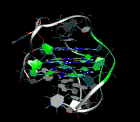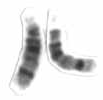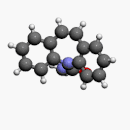Ring chromosome 14 syndrome
Ring chromosome 14 syndrome is a very rare human chromosome abnormality. It occurs when one or both of the telomeres that mark the ends of chromosome 14 are lost allowing the now uncapped ends to fuse together forming a ring chromosome. It causes a number of serious health issues.[2][4][5]
| Ring chromosome 14 syndrome | |
|---|---|
| Other names | Ring 14[1] |
 | |
| Formation of a ring chromosome. | |
| Causes | Caused by a chromosomal abnormality[2] |
| Diagnostic method | MRI, EEG[3] |
| Treatment | Anticonvulsive medication[3] |
Symptoms
The most common symptoms are intellectual disability and recurrent seizures developing in infancy or early childhood. Typically the seizures are resistant to treatment with anti-epileptic drugs. Other symptoms may include:[2][6]
- Microcephaly
- Lymphedema
- Facial abnormalities
- Immune deficiencies
- Abnormalities of retina
- Slow growth
- Short stature
Cause


The syndrome is caused by the loss of genetic material near the end of the long arm (q) of chromosome 14 . The break that causes the telomere(s) to be lost occurs near the end of the chromosome, and is called a constitutional ring. These rings arise spontaneously ( it is rarely inherited).[5][2][7][3]
The genetic abnormality occurs randomly in sperm or egg cells or it may occur in early embryonic growth, if it occurs during embryonic growth the ring chromosome may be present in only some of a person's cells.
Diagnosis
Diagnosis is achieved by examining the structure of the chromosomes through karyotyping;[8] while once born, one can do the following to ascertain a diagnosis of the condition:[3]
Management

In terms of the management of ring chromosome 14 syndrome, anticonvulsive medication for seizures, as well as, proper therapy to help prevent respiratory infections in the affected individual are management measures that can be taken.[3]
Epidemiology
Ring chromosome 14 syndrome is extremely rare, the true rate of occurrence is unknown (as it is less than 1 per 1,000,000), but there are at least 50 documented cases in the literature.[1]
References
- RESERVED, INSERM US14 -- ALL RIGHTS. "Orphanet: Ring chromosome 14". www.orpha.net. Retrieved 17 March 2017.
- Reference, Genetics Home. "ring chromosome 14 syndrome". Genetics Home Reference. Retrieved 2017-03-17.
- Disorders, National Organization for Rare (2003). NORD Guide to Rare Disorders. Lippincott Williams & Wilkins. p. 64. ISBN 9780781730631.
- "Chromosome Abnormalities Fact Sheet". National Human Genome Research Institute (NHGRI). Retrieved 17 March 2017.
- "OMIM Entry - # 616606 - RING CHROMOSOME 14 SYNDROME". omim.org. Retrieved 2017-03-17.
- Zollino, Marcella; Ponzi, Emanuela; Gobbi, Giuseppe; Neri, Giovanni (2012-05-01). "The ring 14 syndrome". European Journal of Medical Genetics. 55 (5): 374–380. doi:10.1016/j.ejmg.2012.03.009. ISSN 1878-0849. PMID 22564756. – via ScienceDirect (Subscription may be required or content may be available in libraries.)
- Kelly, Evelyn B. (2013-01-07). Encyclopedia of Human Genetics and Disease. ABC-CLIO. p. 729. ISBN 9780313387135.
- "Ring chromosome 14 - Conditions - GTR - NCBI". www.ncbi.nlm.nih.gov. Retrieved 2017-03-21.
- Wallace, Sheila J.; Farrell, Kevin (2004-02-27). Epilepsy in Children, 2E. CRC Press. p. 354. ISBN 9780340808146.
Further reading
- Disorders, National Organization for Rare (2003-01-01). NORD Guide to Rare Disorders. Lippincott Williams & Wilkins. ISBN 9780781730631.
- Zollino M.; Seminara L.; Orteschi D.; Gobbi G.; Giovannini S.; Della Giustina E.; Frattini D.; Scarano A.; Neri G. (2009). "The Ring14 Syndrome: Clinical and Molecular Definition" (PDF). American Journal of Medical Genetics. 149A (6): 1116–1124. doi:10.1002/ajmg.a.32831. PMID 19441122.
External links
| Classification | |
|---|---|
| External resources |
|